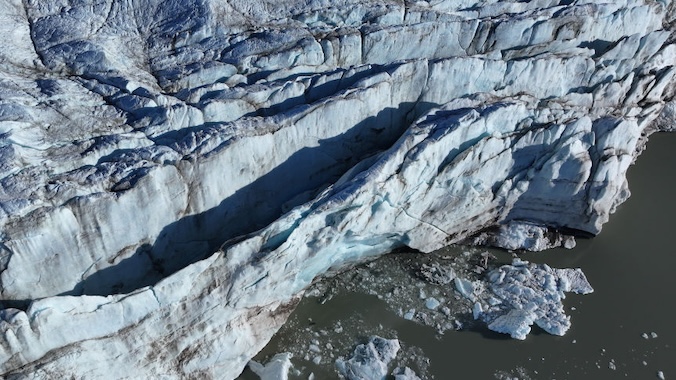At Least One Type of Ice Sheet Catastrophe Is Not Imminent, Study Finds
Photo by Sean Gallup/Getty Images
These days, most ice news is bad — very bad. There are Greenland tipping points just around the corner, Antarctic ice shelf melt inevitabilities, mysteriously disappearing sea ice, among other down notes. So when a study examining an ice sheet collapse process comes back with some results that turn the sea level rise apocalypse dial down somewhat, it is worth celebrating.
In a study published on Wednesday in Science Advances, researchers from Dartmouth, various universities in the U.K., and elsewhere examined a theoretical process known as marine ice cliff instability, or MICI. This posits that when ice shelves, the floating extensions of a land-based ice sheet, rapidly melt and calve away, the exposed cliffs could falter without the shelves buttressing support. Above a certain height, the cliffs could face more pressure than the ice has strength to withstand, leading to rapid collapse of those cliffs. The idea is based on fairly limited observations and guesses about some areas of Greenland; MICI isn’t yet incorporated into ice loss and sea level rise modeling, since it has not yet really been seen in the wild.
The researchers wanted to get a better picture of the process’s potential, especially in West Antarctica, a rapidly destabilizing part of the ice sheet with potential to contribute multiple feet of sea level rise to the entire world in this century alone. They focused, as much research has in recent years, on the so-called Doomsday Glacier, also known as the Thwaites. Using three different ice sheet models, they showed that the area is not actually vulnerable to MICI, at least over the next several decades. In fact, for the process to really take over, the calving rate of the ice around Thwaites would have to increase by a factor of 25; at that pace, the cliff face would start to collapse once its neighboring ice shelf disappeared. But not yet.
“[C]ontrasting our simulations to previous work shows that the onset of MICI at Thwaites Glacier within the coming decades is much less likely than previously argued,” the researchers wrote.
Their results suggest that the height of the cliffs where the pressure gets too intense was underestimated in previous efforts; instead of the process beginning above 80 meters, cliffs under 135 meters may be mostly safe. But while this result is reassuring, the planet’s ice is far from safe. “[O]ur results do not suggest that the West Antarctic Ice Sheet is stable.”
In fact, other recent results at Thwaites point to another important process, and one that is actually worse than previously feared. A study published a few months ago found that warm seawater is intruding beneath the glacier where it meets bedrock, likely causing “vigorous melting,” a phrase that in an ideal world would not be allowed within a thousand miles of an ice sheet. Still, a win is a win.
“Our experiments do not preclude [marine ice sheet instability] unfolding in the future for the West Antarctic Ice Sheet,” the authors of the new study wrote. “Rather, we argue that the hypothetical process of MICI may not play a role in its demise in the 21st century.”